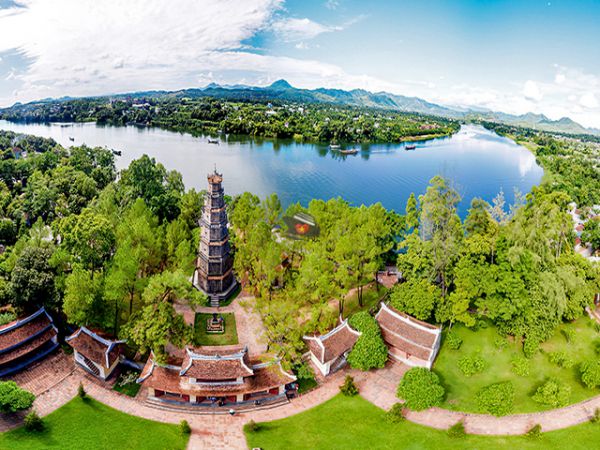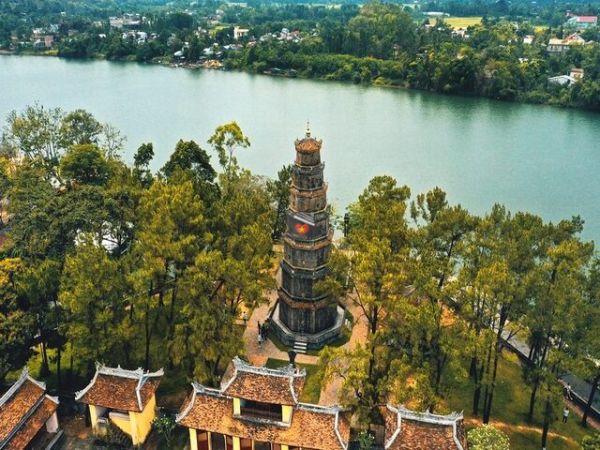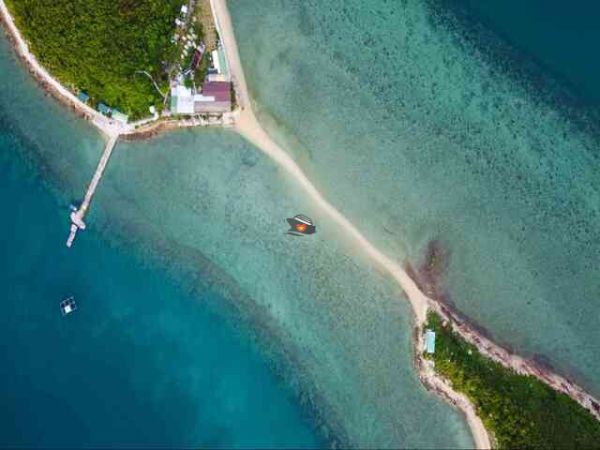THIEN MU PAGODA HUE IMPERIAL CITY

Thien Mu Pagoda Hue Imperial City was established in 1601 by Nguyen Hoang, ruler of Thuan Hoa province. Its structures have been demolished and rebuilt countless times over the ages. Since the 1960s, it has been a site of political rallies, with a memorable incident occurring in 1993 when a man arrived at the pagoda and, after making offerings, set himself alight while reciting the word "Buddha."
Thien Mu Pagoda Hue Imperial City Information:
Address: No 1, Nguyen Phuc Nguyen Street, District Hung Hoa , Hue Imperial City
This seven-story pagoda, built on a tiny hill overlooking the Song Huong (Perfume River) 4 kilometers southwest of the Citadel, is an emblem of Vietnam and as powerful a symbol of Hue as the Citadel. Thap Phuoc Duyen, a 21m-high octagonal tower, was built in 1844 under the reign of Emperor Thieu Tri. Each floor is devoted to a manus-buddha (a Buddha who took in human form).
Thien Mu Pagoda (also known as Linh Mu Pagoda) is the subject of several stories. Locals used to see an old lady dressed in red emerge on top of the hill every night. She predicted that the Lord would pass by one day and construct something significant. Thien Mu Son (Mountain of the Lady from Heaven) was given to the hill after that. When Lord Nguyen Hoang passed by the hill, he heard the history and decided to build a pagoda, which he named Thien Mu. After many events, damages, and reconstructions, the pagoda still stands today and serves as the unofficial emblem of the historic city of Hue.
>> Book your tour now: Chan May Shore Excursions - Gateway to Central Vietnam's UNESCO Heritage Sites
Thien Mu Pagoda Hue Imperial City Sightseeing:
As travelers approach the pagoda, the seven-story octagonal Phuoc Duyen Tower (originally Tu Nhan Tower) draws their attention immediately. The tower was built in the mid-nineteenth century by King Thieu Tri to mark his grandmother's 80th birthday.
Passing through the three-door gate are 12 massive wooden carvings of scary temple guards, and in the center of the courtyard lies Dai Hung Palace, the main shrine of Thien Mu Pagoda. Here, Buddha is worshiped with amazing statues and a big bell that stands 2.5m tall and weighs 2 tons and was fashioned in the early 18th century. All day long, fragrant incense smoke permeates the air, making the prayer for blessings quiet and serene.
A building near the complex's back entrance houses a national relic: the car that transported monk Thich Quang Duc to the intersection of Phan Dinh Phung and Le Van Duyet streets in Saigon on June 11th, 1963, where he burned himself to death in protest of the regime's anti-religion policy at the time.
Visitors to this prominent attraction may appreciate the scenic panorama as well as the characteristic traditional architecture of Hue pagodas. The pagoda gives a breathtaking perspective of both the river and the surrounding environs due to its elevated position over a lovely curve of the Perfume River. This sacred place, which is surrounded by pine trees, bonsai, and a charming constructed pond, exudes a tranquillity that is difficult to find anywhere.

Thien Mu Pagoda Hue Imperial City History:
According to his will, President Ho Chi Minh wanted to be cremated and have his ashes scattered across the country after his death, but the government decided to keep his body intact and place it in the Mausoleum so that people could come to commemorate and visit him.
The Soviet Union and Vietnam's governments met in January 1970 to discuss the design and building processes for the Mausoleum. The task of creating the Mausoleum was then authorized by the Politburo of the Party's Central Committee, with strong backing from Soviet specialists.
The mausoleum's groundbreaking ceremony was held on September 2nd, 1973. The Ho Chi Minh Mausoleum was dedicated on May 19, 1975. The design of the Ho Chi Minh Mausoleum was inspired by the Lenin Tomb in Moscow, which was modified to better suit Vietnamese customs and tastes.
The Ho Chi Minh Mausoleum is a significant achievement that demonstrates the enormous affection that the Vietnamese people have for their leader. Ho Chi Minh Tomb is now not only a cultural and historical landmark of Hanoi, but it also draws a great number of visitors. Many generations of Vietnamese people and millions of international visitors have visited this site since its inception in 1975.
Thien Mu Pagoda is around 4 kilometers from Hue City Center and may be reached by motorbike, bike, or boat. Hon Chen Temple and Minh Mang Tomb can also be visited on a boat cruise. A bike ride is advised because the road is both picturesque and short. Thien Mu Pagoda may also be combined with the Hue Temple of Literature and Huyen Khong Pagoda, which are only a few kilometers apart. One reminder for bikers: the best time to ride is in the early morning or late afternoon to escape Hue's heat.

Hotline/ WhatsApp: +847-6666-0606
Email: info@friendlytravel.vn








.jpg)




